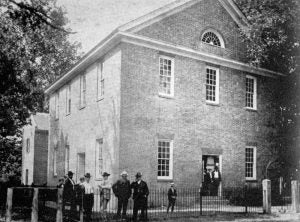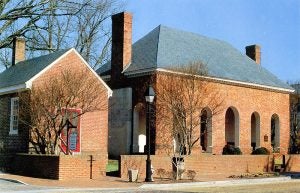Looking back: Courthouses have ‘state-wide significance’
Published 11:35 am Friday, October 27, 2017
by Clyde Parker
Oct. 12, 1967
Southampton County’s courthouse in Courtland, and Isle of Wight’s at Smithfield, share an eminent place today in the architectural, political and cultural history of America, according to the findings of Paul S. Delaney, an associate professor, School of Architecture at the University of Virginia.

This photo shows the Courthouse around 1906, but this is how it looked in 1834 when this structure was built. — Courtesy | Walter Cecil Rawls Library and Museum
The Southampton Courthouse, built in 1834 in Jerusalem (now Courtland), and the OLD Isle of Wight Courthouse, the one in Smithfield, constructed in 1752, have both been cited by the National Trust for Historic Preservation as buildings “having state-wide significance,” and are worthy of preservation.
Some years before the 1752 Isle of Wight Courthouse at Smithfield (then known as Hoggards) was built, the courthouse was located at Glebe Farm, two miles to the west.
(Curiously, Delaney did not make mention of the Isle of Wight Courthouse, built in 1801 at Isle of Wight Courthouse, Virginia. That is when the County Court was moved away from Smithfield.
In 1995, John O. and Margaret T. Peters published a book, titled “Virginia’s Historic Courthouses.” It included information about the Southampton County Courthouse, as follows:
As originally constructed, by Clement Rochelle and Jeremiah Cobb, the 1834 Southampton County Courthouse had no portico and was almost devoid of classical detail. It was an austere brick temple-form building with a pedimented gable, a simple cornice and a lunette window.
The 1834 Southampton County Courthouse was preceded by a Courthouse, built in 1798, that was used in 1831 for the trial of Nat Turner. A few years later, a majority of the judges found it “impractical for the court to hold its sessions in that courthouse,” and they directed that the old Courthouse be removed from the public square and a new courthouse be built there.
In 1924, the addition of the portico gave the 1834 courthouse its present provincial Greek Revival look. A modern addition, constructed in the early 1960s, represents a frank effort to differentiate the old from the new.
In 1997, the paint on the original court building, which was added years ago, was removed. In the year 2000, a colonnade was built. While little effort was made to harmonize the two designs, they do not compete or confuse.)
March 24, 1922
The Tidewater News
By Paul Scarborough, Editor
Our courthouse should be enlarged
The congestion in our county courthouse at the March term of Southampton Court was as great as we have ever seen it although there were no cases of more than usual interest on the docket. And, the bad roads must have kept quite a number of court habitués away. This is the year 1922! In a county of 28,000 population, a courthouse seating only three or four hundred people is much too small; it should be a matter of county pride with us to have a more commodious building. It is true that many people go to court who have no business there, but it is equally true that they have a right to neglect their business and go if they want to. Still, we should have a building large enough to accommodate a reasonable number of our citizens on any and all occasions.
On Court Day, Courtland is literally wrapped up with people coming to town by train, by motor cars, and some, still, by horse and buggy. Many are here for “entertainment” in the courtroom. And, they are patronizing the many stores and vendors up and down Main Street and its side roadways.
The increasing number of people who attend court makes it especially desirable that more room be made either on the first floor or in a spectator gallery, as it was practically impossible to get in or out of the building Monday without the Sheriff to clear the way.
Not only in the lack of seating room but in general arrangements as well, Southampton’s courthouse is way behind the times and has no modern equipment to take care of the Court’s business. There should be a room for the judge, sufficient jury rooms, additional space provided in the clerk’s office and some place where witnesses might stay while waiting their turn to go on the stand or before the grand jury. Sanitary conveniences and a better heating system are other improvements which are needed; and, if possible, a direct entrance from the courthouse to the clerk’s office should be arranged.
We are not advocating any unnecessary expenditures in calling the attention of our people to the present conditions in and around the courthouse, but there is no reason why Southampton should not have a building, adequate for all purposes usually required in the transaction of its business.
We believe that our people would look with favor on some steps toward that end. There is a way to do it and still retain the historical significance of the existing structure.
CLYDE PARKER is a retired human resources manager for the former Franklin Equipment Co. and a member of the Southampton County Historical Society. His email address is magnolia101@charter.net






